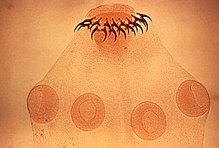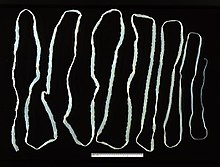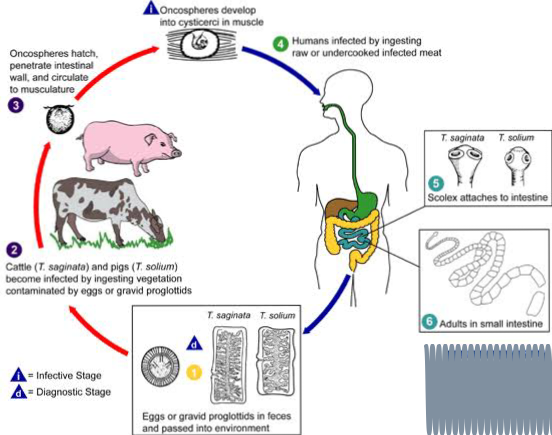Tapeworms are specialized to live an inactive life in the alimentary canal of the vertebrate animal which are their host. The two common species of tapeworm are Taenia solium and Taenia saginata.
Taenia solium is usually infested by pig while

Taenia saginata is infested by cow.

EXTERNAL FEATURES OF TAPEWORM
As the name suggest, the tapeworm is a flat-like creature. The head or the scolex is a small round knob, the size of a pin's head. The body consists of a numerous proglotiles which are flat segmented, budded the narrow neck behind the scolex. Therefore, the segment nearest to the scolex are the youngest, smallest and least developed. The end-to-end arrangement of the segment make up a tape up to 3-5cm long which lies inside the host intestine.
.jpeg)
On top of the scolex is a projection called the rostellum which has hooks round it and four evenly space socker outside. The tapeworm fastening itself to the lining of the whole of the sucker. Tapeworms have no mouth. Each proglottis is secreted from the next groove by transverse and next each have the nervous and the excretory system are shared by all.
INTERNAL STRUCTURE OF TAPEWORM
The point to note about the internal part of tapeworm is the way in which they are being simplified. In this, the digestive system has entirely disappeared because tapeworm do not walk. The life surrounded by the digested food of the host has simply absorb by their blood vessel or special organ of respiration. Below the cuticles, tapeworm has longitudinal layer of circular muscle but they are poorly developed and the worms can only make weak movements.
The nervous system is poorly developed, it consist of a ring of a nervous material in the head to which two longitudinal nerve cords are connected, this pass down the entire length of the worms. The excretory system is simple, it consists of a pair of tubes which pass down the entire length of the body beside the nerve cords through all the proglottis and open to the last segment. These two tubes are joined to each other by a cross tube at the posterior end of each segment. Smaller branches leave from the main duct and extend all over the worm ending blindly in the flame cell.
A flame cell is a hollow structure lined with cilia, it owns his name to the movement of the cilia which are like a flickering flame. Excess water and waste product in a solution are extracted from the body by numerous flame cell and move down the tiny branches by the cilia into the larger excretory tube and finally to the exterior.
REPRODUCTION IN TAPEWORM
Tapeworms are hermaphrodite. Each ripe proglottis is a productive unit with both male and female reproductive organ. A newly budded proglottis from near the head has no sense organs but one near the middle of the worm show both testis and ovule.
~2.jpeg)
The testis can show before ovule when ripe testis shed their sperm which travel along the sperm duct to the genital pore. From there, they pass to another proglottis, this is usually the proglottis of the same animal. It is rare for a host to be infested by more than one worm. When the ovaries are around, they shed their eggs and these are fertilized as they pass along the ovule duct.
After fertilization, the egg receives yolk from the yolk gland and are then covered with a protective shell secreted by the shell gland apart from the uterus. The productive organs breakdown after the eggs have been fertilized.
LIFE CYCLE OF TAPEWORM

The end segment of the tapeworm are rarely just slightly muscular bags of eggs which break away and are discharged with the faeces of the host until new development has taken place inside man, who is called the primary host. Further development can only occur if the discharged embryo are eaten by another animal called the secondary host in case of Taenia solium (this is the pig) and for Taenia saginata (this is the cow).
The digestive juice in the intestine of the secondary host dissolves the protective shell of the egg and the embryo has pores through the new host intestinal wall into a blood vessel. It is carried in the blood stream until it enters the muscles where it settles and grows into bladder worm or CYSTICERCUS STAGE. This consists of a bladder with one piece tucked inside so that it looks like a tapeworm. Head turns inside out.
If an infected pig or cow is slaughtered and a man eat the meat raw or not well cooked, the bladder worm will enter his intestine. Here, the proscolex turns inside out to form the scolex which pass in until the primary host intestinal wall hits its suckers and hooks. Proglottis are formed and a new tapeworm develops. A complicated life history is typical of many parasite. Tapeworm only survive as a species by constantly producing large number of fertilized eggs because, very few of the eggs ever succeed in infesting a new primary host.
TAPEWORM AND MAN
A person infected with a large tapeworm is likely to be robbed of part of his food. As a result, he becomes thin and he's always hungry. There are drugs which kills individual tapeworm but infestation is best prevented.
PREVENTION
(i.) All meat should be examined by meat inspector who can recognize the bladder worm, and meatpork in beef containing them to be destroyed because it is unfit to be eaten.
(ii.) All meats should be well cooked to kill bladder worm.
(iii.) People must use proper latrine to ensure that human faeces cannot come in contact with the food of pig and cattle.
Reference Area
Tapeworms in Humans
Tapeworm infection